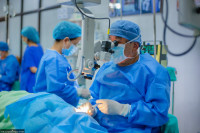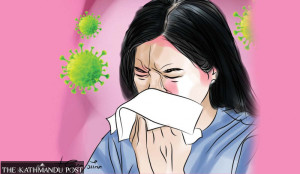Health
Experts warn of outbreaks of water- and vector-borne diseases as monsoon progresses
Landslides and flooding triggered by heavy rainfall have already caused deaths and devastation in several parts of the country.
Post Report
The Sukraraj Tropical and Infectious Disease Hospital in Teku has witnessed an uptick in the number of viral fever cases over the past month. Cases of waterborne diseases—diarrhoea, dysentery, food poisoning, and snake bites—have also been on an upward trend.
Cases of such seasonal diseases have been rising at the hospital since May second week, according to Dr Manisha Rawal, director at the hospital. “We expect a further rise in cases in the coming days,” Dr Rawal said. “Monsoon has just set in and the rains have contaminated drinking water sources.”
Monsoon in Nepal is a season of epidemics wherein thousands of people across the country get infected with water-borne and vector-borne diseases.
Snakebite incidents and resulting deaths are also common during the season but the phenomenon, which experts dub “a lurking invisible crisis”, remains grossly neglected.
According to Rawal, at least six people bitten by snakes were admitted to the hospital on Tuesday.
Around 2,700 people, mostly women and children from Nepal’s Tarai, die of snake bites every year, according to the report of a multi-cluster random survey titled “Snakebite epidemiology in humans and domestic animals across the Tarai region in Nepal.”
Thousands of people get infected with vector-borne diseases such as dengue, kala-azar, malaria, and scrub typhus during this period. Last year, 18 persons died and more than 54,000 were infected with dengue, which had spread to all 77 districts of the country.
On top of that, landslides and flooding triggered by heavy rainfall have already caused deaths and devastation in several parts of the country. Public health experts have warned of outbreaks of water- and vector-borne diseases, especially in disaster-hit areas.
They say sources of drinking water generally get contaminated in the disaster-hit areas and people displaced from natural disasters are highly vulnerable to infections of waterborne and vector-borne diseases.
“All people in the disaster-hit areas are vulnerable to water and vector-borne diseases but small children, pregnant women and elderly people are more at risk,” said Dr Sher Bahadur Pun, chief of the Clinical Research Unit at Sukraraj Hospital. “The authorities concerned should ensure safe drinking water and take measures to save people from the risk of vector-borne diseases.”
Doctors say contaminated drinking water, rising pollution, food poisoning, and lack of awareness are among the reasons for a rise in cases of water-borne diseases.
A recent study carried out by the Epidemiology and Disease Control Division showed that nearly one-fourth of the drinking water being supplied in Kathmandu was found contaminated with faecal coliform, a microscopic organism that lives in the intestines of warm-blooded animals or their faeces.
The presence of faecal coliform means that the drinking water being used by the residents of Kathmandu is contaminated with sewage, doctors say. And such contamination will only rise during monsoon, as most water sources come in contact with floodwater.
Last year, cholera spread in Kathmandu Valley with 70 people getting infected with the disease.
Officials at the Health Office, Kathmandu said they have alerted the health agencies of the growing risk of outbreaks of communicable diseases—both water-borne and vector-borne—and have directed them to be prepared to deal with any situation.
“We have directed the health agencies to monitor the situation closely, and start the necessary preparations,” said Sagar Ghimire, chief of the Health Office, Kathmandu. “We also plan to test water samples more frequently.”
Meanwhile, the Epidemiology and Disease Control division, which responds to an epidemic, said it has alerted health workers on the possible risks.




 8.12°C Kathmandu
8.12°C Kathmandu











%20(1).jpg&w=300&height=200)

